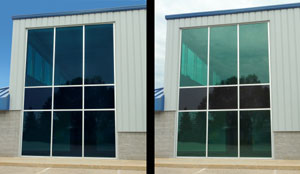Sep 19 2011
PPG Industries and Pleotint, LLC, have agreed to jointly market a commercial window glass system that combines Sunlight Responsive Thermochromic, or SRT(TM), interlayer technology by Pleotint, with SOLARBAN(R) low-emissivity (low-e) glass and other glasses by PPG to control solar heat gain and reduce energy costs in buildings.
Pleotint’s patented technology is a lightly tinted thermochromic interlayer that warms up and darkens in direct sunlight, but clears in indirect sunlight to allow light to pass into a building. Laminated between two lites of glass, SRT interlayer may be used monolithically or within an insulating glass unit. Visible light transmittance (VLT) for windows with SRT interlayer adjusts through the day without the need for wiring, power supplies or controls.
 Window systems with dynamic Sunlight Responsive Thermochromic, or SRT(TM), interlayer technology by Pleotint, LLC, adjust to changes in direct sunlight by darkening to a neutral-gray tint (left) as heat loads increase, then returning to their clearest state (right) as direct sunlight decreases, all without the need for wiring, power supplies or computerized controls.
Window systems with dynamic Sunlight Responsive Thermochromic, or SRT(TM), interlayer technology by Pleotint, LLC, adjust to changes in direct sunlight by darkening to a neutral-gray tint (left) as heat loads increase, then returning to their clearest state (right) as direct sunlight decreases, all without the need for wiring, power supplies or computerized controls.
When the SRT interlayer is combined in a window system with Solarban glass, a proven solar control, low-e glass that also blocks solar heat and transmits visible light, these adaptive windows can dramatically reduce the amount of energy required to cool buildings. Because the windows clear up in indirect sunlight, they also decrease the need for artificial lighting.
A study showed that, due to its ability to dynamically adjust to natural lighting conditions, a window system including an SRT interlayer can reduce energy costs in commercial buildings by 17 to 30 percent over industry-standard window systems. A window with SRT technology also reduces the transmittance of ultraviolet light and short-wavelength visible light, which are major contributors to fading in carpets, fabrics, artwork, photos and other materials.
Unlike competing dynamic windows that require manual, electrical or mechanical controls, windows with the SRT interlayer use the sun’s own energy – up to 1,000 watts of power per square meter – to adjust the window tint and transmittance level. Because the process is entirely self-sustaining, the SRT interlayer system not only uses less energy, it also eliminates the opportunities for failure due to faulty wiring, poor connections or broken electrical circuits. Windows with SRT interlayers also have passed exposure and durability testing developed for electrochromic windows and conducted by the National Renewable Energy Laboratory (NREL).
Insulating units with SRT interlayers and Solarban low-e glass are available in sizes up to 5 feet wide and have been laminated in lengths of up to 11 feet. Architects may specify any OCEANS OF COLOR(R) tinted glass or Earth and Sky high-performance tinted glass by PPG as a base-state window color.